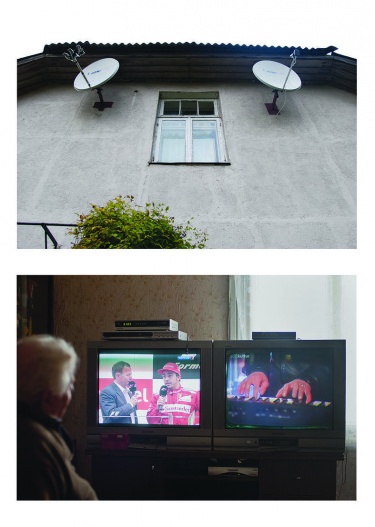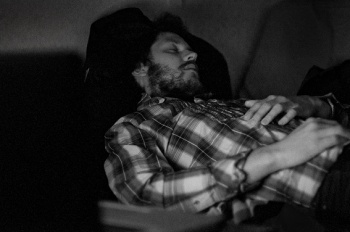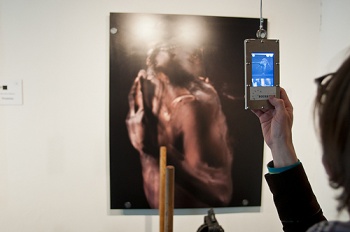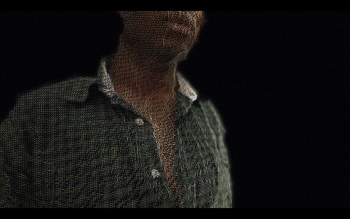Janis project proposal
Tentative Title
Personal judgement
General Introduction
Currently I am interested to work with personal, family related memories and archives. My inspiration comes from the rare visits of my grandparents and the fact that I am distanced from home. Thinking about my instinctive actions of image making in the last years and looking into what is in my archive right now, I would claim that most interesting things for me are related to my personal observations of my relatives, documentations of their daily life and their environment. I see these images as notes about subjects that I find interesting. There are situations that confuse me or make me wonder and appreciate. For example, objects that represent repetition and obsession with something, like my grandmother's passion about cactuses or my uncle's collection of horns and hunting trophies. These issues serve as part of my observations and registration material. Recently, I started to scan my grandfather's photo archive. I got really excited about the images that I found there. I made some selections. They serve as the source material for my project and give an idea about archival principles. To develop the ideas and dig into relevant issues, I started to select images from my own documentation from past years. I want to mix them together with my grandfather's photographs.
I am interested in writing down memories and building up narratives related to my theoretical insights. I started to outline and build bridges between my personal practice and the theories that I am studying. The most relevant issues that I can recognize in my practical investigations so far are kind of abstract metaphors to the theory. They rise up from my memories and images, for example, I discover different approaches of archiving things, interpretation of memories, protectiveness from outside world, protective behaviors while being observed, self systematized methods and observations about different issues, absurdity and obsession with collecting and saving things, etc. The field of interests is the incongruity of things, mix-match of controversial situations which provoke second thoughts. Innocence and purity of the daily life and the occupations is the major research field. By exploring memories and stories, ways of archiving things it will help me to create my own sort of archive of my observations. I want to create photographs and video records, interviews and also try to use other digitization tools.
Practical steps
My next steps would be to write down my memories and see what are the connective parts. In the winter brake I will go back home and visit my grandparents. I want to work more with their photo archive, see what could work for my research. Also, I want to document more the environment and distinguish objects and emphasize details related to the stories. I would like to highlight these things in an observational manner, graphically, create still life compositions from their things. Also, I want to make interviews, record some of their memories about family life, reveal some historical facts. It could possibly help me to understand some issues of miscommunication between the family members nowadays.
Sketches for the possible trigger stories
I am on the way to establish a scheme how these stories are raising each from another, but at the moment I am not able to be precise, because I do not have the visual material. My intension is not to write a script and edit a piece, I would like to be more playful, see whats coming up during the process and edit later. So, here I have listed some of the issues that I find interesting and I would like to highlight, it can vary in the future. I believe that it will become more clear only after my first conscious attempt of approaching my grandparents and other relatives during the winter break.
+ For more than 50 years they have been living in the east countryside of Latvia. For almost all of that time their main occupation was to work with flowers, grow and sell them. My grandmother simply loves any kind of flowers, especially cactuses. At a certain period she had one of the biggest collections in Latvia. Still, she has quite a large greenhouse. Her passion about the flowers is still there also the knowledge about them, repetition of the processes is most important for her.
+ My grandfather has been always obsessed with three things, hunting, cars and documenting the family. I will try to recombine, adjust and recreate it in visual images. In the archive I found a lot of images where he is posing with his catch. Also I found a lot of images that he made with the kids who are holding guns, dead animals or birds. Obviously, for him it was an important issue to document it.
+ My grandmothers passion about flowers, taking care of them and my grandfathers passion about hunting, having the catch. They have totally opposite, I would say controversial, approaches about how to deal with nature;
+ For example, the biggest problem in the family for last 10 years has been miscommunication. Actually, it has always been there. In a way, no one is really attracted each to another as a family member, it is sort of an ego thing, everybody are pretty happy independently and even do not aim for being together as a one whole group. Which probably is nothing special.
+ The biggest dream of my grandmother is to see the whole family together, especially the three sons, sitting by one table. Unfortunately, because of their hard characters, they were always getting in an argument each with another and for last couple of years, maybe even ten, they are not talking anymore. Even not willing to talk.
+ There was always a hunting dog at home. Always. During the summers of my childhood I used to visit my grandparents. I always had a lot of adventures over there. Once, the summer finished pretty early and painful, one of the dogs got crazy and attacked me. It was biting me really hard, later I had a lot of scars, especially in my face. I remember, couple of years after that, I was drawing my self-portrait for my grandmother. I was highlighting lines on my forehead and nose, they were in a reddish blue color till my teenage years and I still have them, only the color is gone.
+ The other thing what is interesting about my grandmother is her passion about crossword puzzles. The way how she is observing and categorizing things by creating her own notebooks - encyclopedias about different subjects. For example about F1 drivers or celebrities.. writing things down and collecting them in a specific way, these notebooks can help to solve the crossword puzzle questions. I want to film it and see how she is organizing and constructing her archives.
+ My postcards, that I received from my grandmother in my birthdays.. She always wrote poetry, really tended to the personal situation, stage of life and my age.. she always combined her thoughts with lines of one latvian poet, a friend of hers..
+ The issue about my uncle who does not want to speak in front of the camera is like a censorship for his appearance in public. Reflecting to a larger context, by displaying his environment and the things that are around him it would revile his personality.
+ The story about the attic and the bomb? Cousins of my grandmother found a bomb after the 2nd world war, they took it home to the attic, they tried to open it and see whats inside. At the same moment, the bomb exploded and the kids died in the attic of the house.. As my grandmother remembers, she was a child, the whole room was splashed with blood, parts of bodies..
+ Other ideas that come up in my mind right now are raising from my childhood memories.. the memories that I have from my grandmothers house and the surrounding things, trees, the well, the dry toilet, the shed.. I would like to reconstruct scenes from my memories of the childhood.. Why I cannot remember clearly things from the time that I spent at my grandparents house? Only parts of scenes: for example, we had a table tennis and a novas table game. Also, we were playing a lot the checkers with my grandparents;
+ I was always curious about things that were hidden from children in the house, there were specific places. Once with my cousin we discovered my granddads hidden vhs cassettes, horror movies and erotic stuff.
Possible outcome forms
It is the archival practice it self, the data is building up the context and structuring and visualizing the memories and ideas as: archiving, collecting things, mixing information and creating personalized "data banks". These are one of the main interests in my research, the observations of how things are interpreted in dramatical ways, how our memories are constructed - based on images and stories, and how our life is affected by them. Finding the romanticism out there. Last year in one of my essays I was asking to my self: In my practice I find references of things that are influencing my perception and way of thinking. For me, it is important to understand where the images and ideas are coming from? And how do I filter them. What actually is my criteria for to save things in my memory/archive/database? And consciously or unconsciously, how do the influences appear in my work, are the they recognizable? What is my added value for my experiments and reproductions?
The final form of the output at the moment can be anything, visual installation, a book, visual essay, prints, it depends of the process and how it is going to develop. The process of decontextualization is important. I believe that it will happen to everybody in a different scale, it depends of interpretation. In the end of the day, my aim is not to show only photos of my family.
I am still willing to experiment with different outcomes, lenticular print possibilities, maybe create some light boxes. I am always amazed by the possibilities of lenticular prints, the option to materialize various digital recombinations and show them on one surface, for example, motion, 3D effect, notion of time, etc. I am interested in back light box format, because it is the closest possible way how to assimilate images that have been reproduced on a display, I find there a connection between the digital image that I have observed on a digital computer screen and the printed version within a back light box.
Relation to my previous practice
In my previous practice I was obsessed with different visual experiments, editing and postproduction techniques. I came up with short fictional stories that I was dreaming about or simply imagining. I was curious how can I visualize those stories by using photographs or moving images.
The video "My slothful dreams" was created in an experimental process as a playful visualization of a recent dream. A tired man with a big bushy beard stands in the bathroom and looks at himself in a mirror. He feels ugly. He wants to shave the beard but he is too shiftless and lazy to do it. He takes off his shirt looks around and suddenly instead of taking a razor he has an idea to try to shave off the beard with his nails and finger tips. He tries to touch his face and the finger tips are becoming razor sharp as well as the nails. The surreal and absurd situation contrasts with a dash of humor within the story line where our reality goes hand by hand with our dreams. The dream translated it self during the editing process and the short storyline established towards laziness and unreal wish theme about avoidance and imagination.
By making "My slothful dreams", I was interested to explore and visualize the absurd situation that I saw in my dream. As the outcome I made an stop motion image sequence that displays the fictional reality.
After that I continued with the dream theme and the explorations of the digital lens based media and experiments with digital images. I was referring to the several exposure technique by overlying images one on each other. I was mixing together several visuals, women characters who are lost in their space and nature landscapes. I was trying to construct the connection and search for an ambiguous space in-between where the character and the two environments would some how fit together. I was pleased by the fact, how two different spaces can merge together and create a third one, construct an photographical, even photorealistic, aesthetically nice imagination.
In the following term I was interested to investigate how a software can generate visual information in between, knowing two coordinates and creating the third one. The visual material consisted from a lot of still images, the sequence was a bit reformed and processed on a computer by using after effects software. There were two results, an high quality, large scale printed image and a fast moving image sequence, both displaying a digitally generated movement. The motion was corrupted by the software, in a way representing time and deforming the natural body moves. The video is the hidden augmented world of the work, it can be revealed when a smartphone is directed at the photograph. On the digital screen the hidden reality unfolds engaging the spectator and resulting in a strong connection with the photograph it self.
Again, it explored the boundaries of lens based medium, unfolded another way of a visual interpretation and raised a question why the post-photographical qualities are interesting in nowadays? It is yet another way of manipulating reality, another way of experiencing it by using these contemporary tools. At the moment I am questioning myself, what qualities from these experiments I can borrow and put into my visual language grammar section, what does it add to my working methodology?
In the last trimester of the first year, I merged my ideas with Javier Lloret and we created the project "Human Stock". It is a video presentation about a fake media company which actually does not exist. In the video actors are describing the utopian plans about the platform and how it is going to change the visual media industry.
The platform is offering an online stock library of 3D photorealistic visuals of real human beings. Customers from the industry can browse an online store, purchase and download any of the 3D model stock visuals. It has a potential to create wholly new markets and employment opportunities, and change the visual language of perceiving images.
Conversely, the Human Stock is offering to anyone the opportunity to have their body digitized for the 3D stock library, using the automated, easy-to-use 3D full body scanner booth. Each model/supplier can earn a fixed percentage of the revenue generated with each download and use.
The video advertisement consists of interviews in which the founders explain how it works and some of the users are giving feedback of their experiences. It is a trailer/mockumentary which gives a short description about what Human stock is and how it works.
The fake company has been created as an inspiration by Apple and other powerful companies and service platforms, admiring their aims and products. Sometimes they are producing utopian things, and representing them in an even more bizarre level, they are real but kind of "on the edge" with the reality, revolutionary as they say. Promising one thing, but behind it stands something else. For example a track for online marketing tools.
Any how, it is interesting to see how people are reacting to these kind of revolutionary services and products. Also, what kind of questions are raised after seeing Human Stock "proposal"? Do people believe that it is a real company or just a fiction? How far can I go to make people believe and convince them that its harmless? Do people understand that it is a fiction or it does not matter?
With the technology that is out there some company could actually provide this service. Would people use it and do not think about the consequences? For example, that it is possible to loose the track of their personal digital image and the way how and where it has been used? How much control do we have currently with the real online services where we share our images and information with others?
References
Theory:
Nicolas Bourriaud, Postproduction 2002;
Nicolas Bourriaud, Relational aesthetics;
Lev Manovich, New Language of Cinema;
Kant after Duchamp - Thierry de Duve;
Nestor Garcia Canclini, Remaking Passports; Visual thought in the debate on multiculturalism;
David Joselit, What to do with Pictures, October 138 about Digital Arts;
De Mul, J. (2009). The work of art in the age of digital recombination. Digital Material. Amsterdam: Amsterdam University Press. 95-106.
Kessler, F. (2009). What you get is what you see: Digital images and the claim on the real. Digital Material. Amsterdam: Amsterdam University Press. 187-197.
New Media, Old Art Forms: Art in the Age of Digital Reproduction, Department of English Studies, University of Strathclyde;
Quiring, B. (2008). Reframing the Open Archive: A Live Show
Foucault, M. (1969). The Archaeology of Knowledge. Translated by Allan Sheridan Smith., 1972. New York: Pantheon Books.
Sekula, A. (1983). Reading an Archive. Photography between labour and capital. In: L. Wells, ed. 2002. The Photography Reader. London: Routledge, pp.443–452.
Quaranta, D. (2011) The Artists as Archivist in the Internet Age. In: D. Quaranta, ed. 2011. Collect the WWWorld.
Derrida, J. (1995) 'Archive Fever. A Freudian Impression'. Diacritics, 25 (2), 6-63.
David Campany. Photography and Cinema. 2008
Artists:
Duane Michals
Thomas Ruff
Banksy
Oliver Leric
MacDonaldStrand
Ryan Mcginley
Omer Fast
Kirby Ferguson
AES+F
Austin Kleon
Veronique Bourgoin
Richard Billingham
Fabio Messias
Donald Weber
Adam Broomberg & Oliver Chanarin
Erik Kessel
Christian Patterson
Alec Soth
David Chancellor
http://www.instituteartist.com/
Movies:
Exit through the gift shop. Banksy
Hugo
Who gets to call it art. Henry!
The tree of life
Good copy, Bad copy
Press pause, play
Vvversions. Oliver Laric
Everything is a Remix






